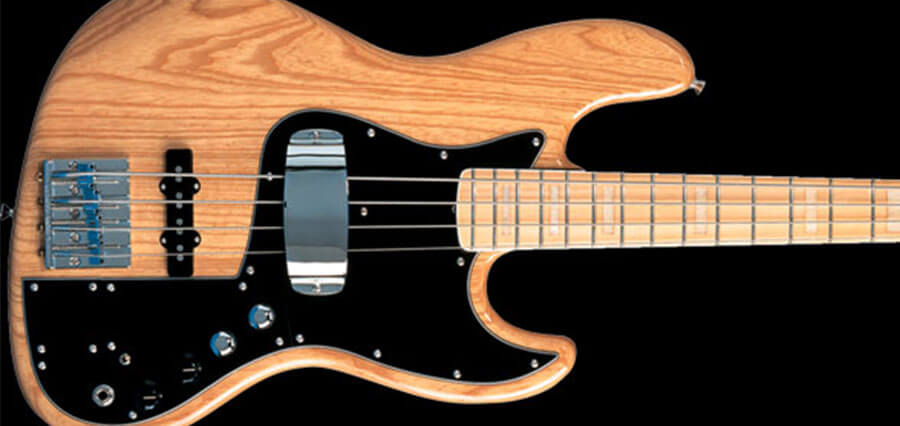
I’ve previously mentioned that a lot of my gear had been bought out of necessity or problems I had to address rather than just sheer lust or G.A.S. (Gear Acquisition Syndrome) so this Fender Jazz and it’s subsequent modifications are a perfect example. I’d been using an Ibanez SR1000 as my main bass for several years, which had been perfect for most bands and styles. It was lightweight, had a really punchy tone in the midrange and a super fast 24 fret neck. But most of the gigs had been more pop orientated . All of a sudden I found myself in a situation playing a wider variety of styles such as ballroom, jazz, country etc. and felt like I was lacking in that deep fundamental bass tone. So after shopping around several music shops I came across this Fender Jazz Marcus Miller signature bass and instantly fell in love with it.
It’s a big, solid instrument based on Miller’s 1975 Jazz original but with stock Fender pickups and electronics as opposed to the Bartolini preamp he had fitted by Roger Sadowsky. The fret spacing is fairly wide and the neck is quite thick (especially after playing the Ibanez) but it all adds up to feeling very stable and strong. This combined with the 20 frets and shallow cutaway might initially make it less desirable for technicians that yearn for lightning fast, high register soloing but, as Marcus Miller has shown, it is more than adequate for most purposes. The large pickup cover might also be a hindrance for some people but that can be easily removed. I did remove it for a few months but eventually reinstalled it just for the cool retro vibe.
The stock Fender Vintage Jazz pickups and active preamp result in a turbo charged take on the standard, recognisable Fender Jazz growl. With both pickups at maximum, the deep resonant sound of the instrument can give slapping and neck based fingerpicking that Marcus Miller sound many players will be after.
After playing around with it at home for a few weeks I took it away for a 5 month gig contract and really put it through its paces. It was during this period that I came up with a few modifications and additions. The first issue I had to address was the weight. For a couple of sets a night and maybe a couple of gigs a week it’s completely fine but I had embarked on a gig playing every night/day of the week with between 5 and 7 sets per day, each at 45 minutes per set minimum. After a few weeks my shoulder began to ache and after a month it was becoming unbearable. I’d never really paid much attention to the comfort of my straps. It was usually a case of finding something reasonably attractive and available in whatever music store happened to be in the area. This time I spent a little time perusing the web for opinions and reviews and settled on a Neotech Courroie Super Basse. The springy Neoprene is not to every player’s liking but I find the soft material to be much easier on my shoulder even after several hours of use and the weight of the bass is distributed much better than other conventional straps I’d used.
The next problem I ran into was hum. One of the stages I regularly performed on had a combination of bad electrics and a mass of lighting that would regularly cause havoc with my sound. The main problem would be hum and I was already aware that single coil pickups can be particularly prone to noise when soloing one or the other. I now wish I had read this thread on the talkbass forum earlier as shielding also seems to be an issue on many of the Fender Marcus basses:
http://www.talkbass.com/wiki/index.php/Silencing_the_Noise_on_a_Marcus_Miller_Signature_Bass
Whilst scouring the internet for reviews of hum-cancelling pickups I also found myself pining for a new active preamp. The two volume pot configuration of most Fender Jazz basses has always been a problem for me. I have a tendency to mute between songs by turning the bass volume knob to zero. Two volume pots can become a chore especially if I find a sound I like that involves setting a knob somewhere between zero and 100% (which is exactly what was happening). Also, some of the theatre/cabaret gigs I played had sound engineers with a preference for using a DI box rather than the balanced line output of the amp. In this case, I wanted to be able to make small adjustments to my tone straight from the bass instead of the amp. This was mainly an issue for me when moving between fingerstyle and slap techniques or between styles such as pop/funk, jazz and ballads. So I devised a criteria for an active circuit requiring a pickup blend, treble, bass and mid as opposed to the dual volume, treble, bass configuration.
My search led me to purchasing a set of Dimarzio Ultra Jazz pickups and a John East Marcus retro active preamp. The Dimarzio’s completely solved my single coil hum problem and provided a slightly darker sound, probably due to a slight scoop in the mid range which is great for slapping but takes a slight edge off the bridge pickup growl.
The John East preamp was a revelation for me. The Marcus Retro is all fitted to a replica scratchplate section so it can be soldered straight into the bass with minimum fuss. The preamp comes with 3 concentric pots: A volume/pickup blend, Treble/Bass and a Mid/Mid frequency select. An extra pot provides passive tone control as per a standard Fender Jazz while also having an overall impact on the active sound. The passive/active switch is still present and a further switch acts as a pickup select when in passive mode. This all adds up to a huge palette of tonal choices in a convenient layout. I could finally turn my volume to zero in one hand movement and finely tune my balance of the two pickups independently. The parametric mid section is wonderful for finding sweet spots in a mix and can overcome the scoop in the Dimarzio’s if needed. The treble and bass controls have a hell of a lot of boost to them and I find myself keeping the bass pot (which is boost only) back at zero most of the time.
My final modification to the bass came in the shape of a Hipshot Detuner. I had spent a few years becoming frustrated at some of the odd keys used for certain songs because of vocalists or brass sections. This could be down to moving from a male to a female key for comfort or simply out of inadequacies in range. This was prior to me moving into 5 string territory and I would generally play things up an octave or detune for a song if needed. But some songs can provide difficulties. The perfect example is a song called Hot Hot Hot by Arrow. This song is a cruise ship standard and I would advise any player to learn the basic slap pattern before embarking on a cruise job. The problem comes with transposing the songs to anything lower than E. The original is in F and involves a octave slap, high to low. A band I regularly played with had transposed the song into Eb. If you take the pattern up an octave, the Eb has to be slapped high on the G string which sounds all wrong. The only solution, if you don’t have a 5 string, is to detune the E string to Eb and this was my preferred way of playing it. But the detune has to be performed between songs and I regularly had to play it in a segue that would only allow a few seconds to drop the tuning. To make matters worse, the song would usually be played at a loud deck party with lots of crowd noise, drums and wind making it virtually impossible to detune by ear. This led to two ways of retuning, either using a tuner in mute mode (which can take longer than you would imagine when measured in seconds) or memorising the position of the tuning peg in the standard and detuned states. In practice, the memorisation method was the quickest way to detune and I became fairly accurate but it was still not perfect and resulted in a certain amount of unnecessary stress at that point in the gig. I had always known about Hipshot Detuners since seeing Billy Sheehan rave about them on one of his instructional videos, so it didn’t take me many months of the afore mentioned shenanigans before ordering a shiny new tuning peg.
After the straightforward install, I much preferred the smoothness of the Hipshot tuning peg to the stock Fender and, as expected, the detuning facility was perfect for dealing with quick tuning changes. The detune position can be set to your own preference (I have it generally set to Eb, but have tuned it to D for certain songs in the past) and a simple pull of the lever instantly drops to the preset tuning. Even though I’ve now been using the Hipshot for 10 years, I still prefer using the detuned Fender for slapping over a 5 string.
So, in conclusion, the Fender Jazz Marcus Miller edition bass is a great all-round bass in its stock state, but with the modifications it has become a great workhorse bass that I will probably never sell. It’s hard to rate instruments for other musicians since every musical situation is different and every player is different. It’s only after gigging an instrument for a while that you can make a judgement on whether it works for you and it’s surprising how necessity can give rise to modifications of an instrument that you would have never considered during the initial shopping spree.


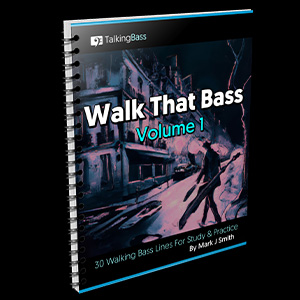




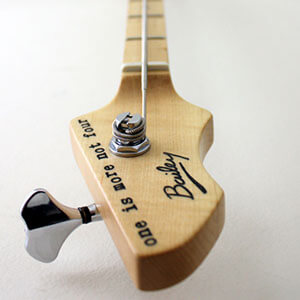

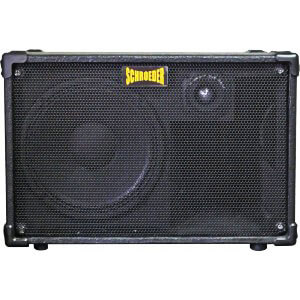
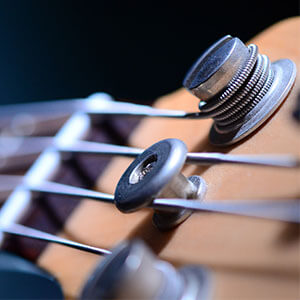


This is a really useful article. I have a 2004 Fender MIM Jazz Bass, which I love, but when I bought it, it suffered from hum and noise, to the extent that the effects on my Bronco 40 practice bass amp were creating all sorts of horrible noises and were unusable.
I also had a problem with the pots, which were clearly original and had become noisy and intermittently lost all signal, needing a “twiddle” to get them working again.
I decided to follow Mark’s advice and bought a pair of DiMarzio UltraJazz pickups, but I didn’t want to “go active” because I wanted to avoid batteries and having to remove the control panel each time a new battery was needed – and I didn’t want to start modifying my lovely bass by making a hole in the back for a battery cover. So I decided to replace the controls with a new pre-wired control panel from Richter – here is a link:
https://www.bestbassgear.com/richter-jb-vbt.htm
I decided to use the version that has a single volume control, a blend control for the two pickups and a tone control. The panel uses completely sealed pots, a printed circuit and there’s no need for any soldering. It’s very high quality and well made (I was an electronics engineer in my earlier career, so I’m qualified to judge).
I also screened the pickup and controls cavity with copper foil, connecting the foil back to the jack earth side.
The result – all hum and noise had completely disappeared, the effects on the amp now work great, and the sound of the bass with the new pickups was greatly improved.
Thanks Mark, great advice! Cheers.
Wow, thanks. That was an extremely well written and thoroughly detailed review! Enormously helpful for people like me who play for fun but more importantly those who are lucky enough to play bass for a living. If this bass can take me even a fraction closer to sounding like Marcus then I’m in….just need another 10,000 hours of practice to get me to first base (ugh!). Thanks
I’ve done pretty much the same for my ‘91. EMG JVs, Hipshot Dtuner and an Aguilar OBP-2.
The original (authentic) pre was boost only and a bit limiting. The Aguilar is cut/boost and has a pan control.
It’s now a (tbh pretty heavy) beastie that feels gorgeous and sounds amazing. Very responsive and a core part of my bass arsenal.